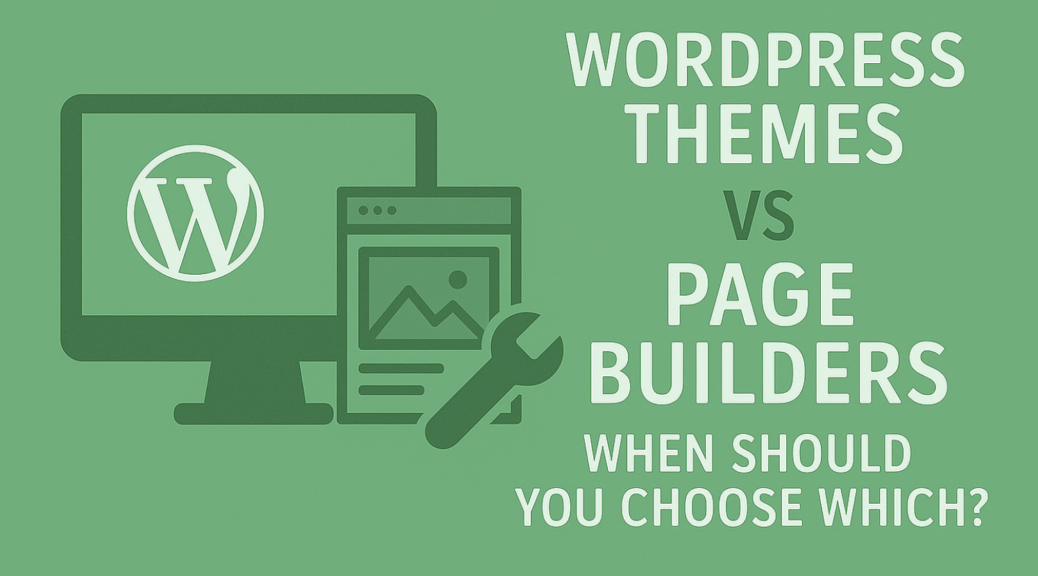
WordPress Themes vs Page Builders: When Should You Choose Which?
When building a WordPress website, one of the biggest decisions you’ll face is whether to rely primarily on a WordPress theme or use a page builder like Elementor, Divi, or Beaver Builder. Both options have their strengths and weaknesses, and the right choice depends on your goals, technical comfort, and long-term vision for your site.
In this article, we’ll break down the differences, compare their performance, and provide recommendations to help you make the best decision.
1. Theme vs Page Builder: What’s the Difference?
A WordPress theme is a collection of templates and stylesheets that define the look and layout of your website. Themes often include ready-made designs, headers, footers, and customization options through the WordPress Customizer or block editor.
A page builder, on the other hand, is a plugin that lets you design pages visually using drag-and-drop elements. Instead of relying on prebuilt layouts, you can create complex designs from scratch—even if you don’t know how to code.
In short:
- Themes = define the foundation and global design.
- Page builders = allow custom, per-page designs with high flexibility.
2. Performance and Complexity
One of the most important factors in 2025 is performance. A fast site not only improves user experience but also boosts your SEO rankings.
- Themes: Lightweight themes (like those from Vilho Design) are optimized for speed, with minimal code and streamlined structure. They rely on WordPress’ native block editor, meaning fewer scripts are loaded.
- Page builders: While powerful, they often add extra layers of code, JavaScript, and CSS. This can slow down your site, especially on mobile devices. A page builder site may score lower in Google PageSpeed or Lighthouse tests compared to a lean theme.
If performance is your top priority, a well-coded theme will usually outperform a site built entirely with a page builder.
3. Maintenance and Updates
Every WordPress site requires maintenance, but the complexity depends on your setup.
- Themes: Regular updates from the developer keep your theme compatible with new WordPress versions. Since themes are more streamlined, there are fewer potential conflicts.
- Page builders: They must be updated frequently to stay compatible, and because they interact with so many site elements, conflicts are more likely. This can sometimes lead to broken layouts after updates.
For users who value stability and low-maintenance websites, themes tend to be the safer choice.
4. Learning Curve and Ease of Use
Ease of use depends on what kind of user you are.
- Themes: Out-of-the-box themes are often easier for beginners. You install, activate, and make adjustments via the Customizer or block editor. You don’t need to design each page from scratch.
- Page builders: They offer great flexibility but come with a steeper learning curve. You’ll need time to understand the interface, widgets, and responsive settings. For some users, this flexibility becomes overwhelming rather than empowering.
If you want a site that looks professional right away, a theme provides the quickest path.
5. Flexibility and Limitations
This is where page builders shine—but not always for the right reasons.
- Themes: Provide consistent design across your site. You can still customize layouts and styles, but within a framework that ensures a cohesive look.
- Page builders: Allow pixel-perfect control of each section, but that flexibility can also lead to inconsistent designs if you’re not careful. Sites can feel cluttered if every page looks different.
If brand consistency matters, themes usually enforce a cleaner, more professional style.
6. Examples and Benchmarks
- A business website using a lightweight theme might load in under 1 second with optimized hosting. The global design ensures every page feels unified.
- The same site built entirely in a page builder could take 2–3 seconds to load, with more requests and larger file sizes. On slower mobile networks, this delay becomes noticeable.
That doesn’t mean page builders are bad—just that they require more optimization and discipline to reach the same performance level as a theme-first approach.
7. Recommendations: When to Choose Each
- Choose a theme (without page builders) if:
- Speed and performance are top priorities.
- You want a stable, low-maintenance site.
- You prefer a consistent design across all pages.
- You’re comfortable working with WordPress’ block editor.
- Speed and performance are top priorities.
- Choose a page builder if:
- You need complex custom layouts that go beyond what a theme offers.
- You want full visual control of every page element.
- You don’t mind trading performance for flexibility.
- You have time to learn and maintain the builder.
- You need complex custom layouts that go beyond what a theme offers.
At Vilho Design, we believe most websites—especially business, blog, or news sites—benefit more from a lightweight theme than a heavy page builder. Our themes are designed to give you the speed and simplicity you need, while still allowing enough flexibility to adapt to your brand.
Final Thoughts
The decision between a WordPress theme and a page builder doesn’t have to be complicated. If you value speed, simplicity, and long-term stability, a high-quality theme is often the smarter choice. If your project demands unique layouts and you’re willing to optimize carefully, a page builder may be worth it. This is an important decision no matter which type of website you are working on – whether it be be a news site like NordNews.se , a educational children blog like Legeaben, or even a recipe site like Farfarsmad.dk
The key is to understand your goals and choose the tool that aligns best with them. With the right foundation, your WordPress site can be both beautiful and lightning-fast.